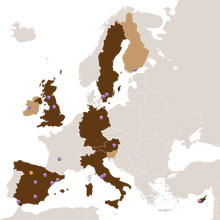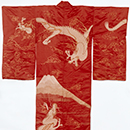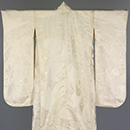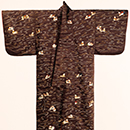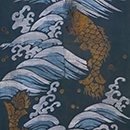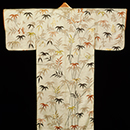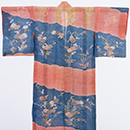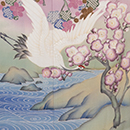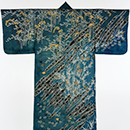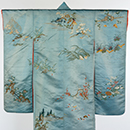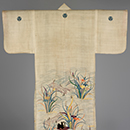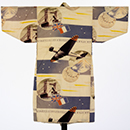| THE ART OF THE CUTLER
In years past the late Tom Sewell wrote extensively in these pages about Jean Jacques Perret, the 18th century French master cutler and surgical instrument maker who was, very likely, the greatest knifemaker who has ever lived. Perret was the man who, beginning as a teen-ager, worked in and learned the trade secrets of every cutlery center in France. Perret was the man who did a full course of study at medical school, in order to improve the quality of his surgical instruments. Perret was the man who said that a practical test of a cutler's skill was for him to draw out from bar stock a steel wire 6-1/2 inches long and 1/6 inch in diameter, and then to drill a 1/12 inch diameter hole through this wire with his breast drill -- the long way. And Perret was the man who, in 1771, wrote and illustrated what is still the finest knifemaking how-to book ever published.
Perret's book is called L'Art du Coutelier -- "The Art of the Cutler". It includes three large thick volumes, the latter two dealing with surgical instruments, and all three illustrated with hundreds of splendid engravings.
Every aspect of knifemaking is covered, from engineering design and materials preparation, to the art of selling and shop management. Of course some of the material is obsolete, such as the parts pertaining to pre-Revolutionary French business practices, although even here we might learn a thing or two. Most of Perret's technical material, however, is as valid today as it was when it was published, over 220 years ago.
Today we might use power saws instead of hand saws to cut ivory, horn, or wood handle slabs, but the principles of sawing these materials to achieve stable dimensions and attractive grain have not changed at all. Today we might use refined steel alloys that Perret never dreamed of, and we might buy ready-made drill bits and lathe cutters where Perret made his own, but when it comes to shaping those alloys and using those tools, Perret could teach most of us a lot more than we could teach him.
I imagine that Perret would be pleased to see the current popularity of damascus steel in hand-made knives today, both in America and in his native France. Perret made many damascus knives and swords, as did other Parisian cutlers both before him and after him. Some of his contemporaries even made fake damascus, and Perret exposed their shady methods.
As far as we know, no one in Europe at that time made eastern damascus, what we now call Wootz. However Perret and his fellow European cutlers were familiar with that material, and recognized that it was different from their own product. Perret called it le Damas naturel "natural damascus." Since we now know that the pattern in Wootz forms spontaneously, this seems to be a very appropriate name.
Damascus steel was such a popular topic in Perret's own day that he felt called upon to include an entire chapter on its fabrication in The Art of the Cutler. This is Chapter 29, "Maniere de faire l'Acier facon de Damas" ("Method of making Steel in the style of Damascus"). Here is a somewhat loose translation. [Note: the "inches" (pouces) referred to are French Royal inches, which are 1/12 longer than our English inches.]
| |
Method of making Steel in the style of Damascus
Jean Jacques Perret, 1771
We might have discussed this steel in the chapter on materials, because it is one. However, since it is not appropriate for fine cutting edges, we believed it our duty to treat it separately, although this steel does serve very well for making table knives.
This material, which closely imitates "natural" damascus, can become costly. This is because of the time required [to make it], as well as because of the quantity of coal one must employ, and the diminution of the metal [during fabrication]. If one wishes to make 3 pounds weight, it is necessary to start with 6 pounds weight of raw material.
Start out by forging six thin plates of iron, exactly identical in all respects. Let us suppose that they are each a pouce (an inch) wide, a ligne (1/12 inch) thick, and 12 inches long. Then forge five thin plates of steel, identical in form to those of iron, making in total eleven thin plates. The more plates one uses, the finer the material will be. Stack these plates one atop another, but be sure to put each steel plate between two of iron, which means starting and finishing with an iron plate. This is how it must be done, no matter how many plates one uses. This should become clear from Figure 1.[In the figure] each thin plate is numbered from 1 to 11, and under each number one sees a letter that designates the material: A for Acier (steel) and f for fer (iron).
| |
 | |
Once all this is properly arranged, grasp all the plates with a tongs. Clamp the handles of the tongs with an "S" as shown in Chapter 12. Place this stack in a moderate fire. Raise the temperature so that all the plates heat uniformly through and through, but do not allow any of them to burn. To this end, turn the packet often in the fire, without removing it, and then let it rest in the fire a little while. The plates that are in the center will not heat up as fast as those on the outside, mainly because the latter receive heat directly from the coals, while those in the center receive none except from their neighbors. Finally, when the whole thing is uniformly hot, moderate the pumping of your bellows, "sand" [i.e. dust with flux] the material at least twice after each heat, and forge it squarely, working it down to a thickness of 8 or 9 lignes (2/3 to 3/4 inch) on a side. After this is done, heat the material up to a bright red, but not quite white, and clamp one end in the vice, as shown in Figure 2.
| |
 | |
With stout tongs twist the material from one end to the other, as evenly as possible, so that it resembles a screw, as shown in Figure 3.
| |
 | |
Now it is necessary to flatten and forge it out to a width of 9 lignes (3/4 inch) and a thickness of 3 lignes (1/4 inch). After this fold it in two [the long way], in the manner shown in Figure 4.
| |
 | |
All this work, up until now, is for nothing other than to form a strong tenacious covering, such that no effort or power can break it apart. The plates of soft iron are thoroughly welded, married, and entwined with the ones of steel, forming together an extremely tough material, more tough than either component. The iron and steel are well bonded together, and the individual particles of each are very small. However, it is not possible for this material to be given a really fine cutting edge. The "veins" of iron that wind throughout prevent it. Make, therefore, a thin plate of good German steel 9 lignes wide, Figure 5, (that is, the same width as the covering), and at the very most 2-1/2 lignes thick; its length must be equal to that of the covering which has been folded in half.
| |
 | |
Put this steel plate between the two sides of the covering. Then forge weld the whole assembly. Do not overheat the billet. Avoid striking it too hard. Use only the face of the hammer. Shape the surfaces squarely, so that the steel remains always in the center of the billet, because upon this depends the quality of the cutting edge. Then draw out the billet to the length and width which you require.
A blade made from damascus material can never break, save only by forcefully bending it back and forth many times. Therefore it makes a strong knife. And if one tempers this knife to the color of red copper, after having hardened it at a cherry color, one would be able to cut iron very readily with it, without the edge chipping, provided however that one made the edge a bit thick and rounded. But if one is making this knife to cut food at the table, and one does not wish to show off with it, one should give it a little finer cutting edge, which requires no more than tempering it to a gold color, instead of red copper color. Then one will have a good tool which will cut well, and which will keep a good edge for a long time.
If men did not seek so often to pinch pennies on that which is useful, all the while making huge expenditures on useless ornamentation, then instead of having a sheath knife worn at one's side whose blade cost not even 40 sols (five-cent pieces), but whose mounts cost 60 livres (pounds); one might instead have a blade which cost 60 livres, in mounts which cost 40 sols. Nothing can make a better blade for a Couteau de chasse (literally a "hunting knife," but actually a hunting sword, or hanger) than damascus material just as I have described. Its utility is found in the implement's requirements [chopping through bones]. The object for which this material is nearly indispensable is the Damas a decoler, the damascus beheading sword.
| |
 | |
Figure 6 represents the one which is used by the Honorable Mr. Sanson. [Charles Henri Sanson, 1740-1795, was the public executioner in Paris. He was to preside over the execution of Louis XVI in 1793.] His sword is 9 inches long in the handle, between A and B, and 3 feet in the blade (3 French feet, or 39 English inches). The width is, at the base of the blade, 2-1/2 pouces, tapering very slightly to C. Its thickness below B is three lignes (1/4 inch), but it thins steadily right up to the point, where it is but one ligne (1/12 inch) thick at C. This makes it more flexible than an epee. It is double-edged and does not have a sharp point. On the contrary it is well-rounded, because a sharp point can get stuck in the vertebrae. Being rounded and well polished, it slides and cuts easily. Its edges are the same on both sides, and it is as keen as a fine pen knife that is used for sharpening quills. It is necessary that it be polished the long way on a polishing wheel which is at least an inch wide, taking careful precautions not to injure oneself. It must be honed on a razor stone, or else on a fine-grained Levant stone. This is what I have always done.
On might well think that forging damascus material and forging pure steel are much the same thing; in either case one must treat them with "art" in order to preserve their "virtue." However, it is necessary to forge damascus with a great deal more care. Once it is completely welded throughout, it is not necessary to give it additional welding heats. Most of all, in the final heats, do not heat it past cherry color, and in the last heat past the color of bronze. Then hammer the material well until it is cold. One need not be ashamed to use files to shape it. File it without additional reheating.
The hardening, which gives the final touch of quality to this material, must be done with all possible attention. For such a piece as this, do not use just any forge. Instead light, on the ground, a charcoal fire of sufficient size to surround and heat the entire piece. When the fire is burned down to coals, put the piece in the center and cover it completely with hot coals. Do not use a bellows, but only agitate the air with a piece of cardboard, or something equivalent. Pay attention that the blade heat uniformly throughout. As soon as it has reached a bright cherry color, plunge it into a big bucket of water, or a big cask of water if the hunting sword or saber is three feet long.
Some people brag about certain other hardening methods which, if truth be told, do not have anything wrong with them. However, since we discussed this subject elsewhere, I will not say any more about it here. I will merely point out that with proper attention paid to forging the steel, and to the degree of heat in the hardening, plain cold water is worth more than all the ingredients which one might add to contaminate it.
When damascus is polished, the eye of the connoisseur can judge if it is really damascus, because one can distinguish the flowing whitish veins of the iron from the bluish veins of the steel. However, for giving effective color to damascus, and to make those veins stand out, pour a little eau forte [dilute nitric acid] on to the piece (completely finished). Spread it out over the entire length of the blade with a feather. Leave the acid on the blade for the space of 6 or 7 minutes. After this time rinse the blade with clear water, dry it, and you will find it damassee, which is to say one may readily distinguish the veins of steel from those of iron.
In general, steel is subject to having closely spaced veins. [This is a feature of shear steel, the best type available in 18th century France.] In consequence one can be fooled, and buy steel blades which are not damascus, because it is only necessary to wipe a knife, a razor, &c, with some acid, to give it the color of damascus. However, one can judge [real damascus] by the regularity of the "flowers," and by the veins of iron which flow with a sort of regular symmetry. On can also recognize damascus steel, worked the way we have described, by its being largely forged to shape, and because its veins are small and evenly distributed, and because the metal is of good quality.
I have seen some hunting swords which were sold as damascus, but which I suspected not to be, in part because the blackish veins were too deep, and in part because their edges would not cut iron. Indeed their edges were so blunt and ill-shaped that they would not even cut wood. I tried to discover the method of "damascening" blades as boldly as these. After several trials I took a blade of polished steel and I covered it with a coating of wax, which I let drip from a lighted candle. I spread the wax evenly over the entire surface. Then I drew a quantity of lines in the wax, using a steel scribe which served me as a pencil. After that I poured some acid on the wax. I allowed it to bite or dissolve the steel which my "pencil" had uncovered for about an hour. I then cleaned it off, and found that I had discovered the whole secret.
Figure 7 shows a hunting sword with blade made of damascus.
| |
 | |
 |
Translate
Saturday, April 9, 2016
Method of making Steel in the style of Damascus
Bringing Ancient Sounds Back to Life
Music is the “sound-evidence” of Europe’s ancient common roots.
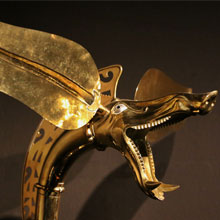
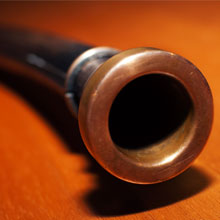
Long before the Old Continent became known as Europe and before the presumed "history of music" began, musical instruments played a key role in creating a network of interconnections, cross-references and shared features among the various European cultures.
The European Music Archaeology Project (EMAP) is the first organic journey from the sounds of Prehistory through to traditions which still survive today, taking us from very early music to the present day composer and blending archaeology and art, science and creativity.
The European Music Archaeology Project (EMAP) is the first organic journey from the sounds of Prehistory through to traditions which still survive today, taking us from very early music to the present day composer and blending archaeology and art, science and creativity.

Concert
From the Cave to the Rave - April 9th, 2016, 19:30 - Venue: Royal Conservatoire of Scotland, 100 Renfrew Street, Glasgow, UK
Astounding reproductions of ancient musical instruments and sound tools - from European prehistory until the dawn of Western Music - will be gathered together in Glasgow for the very first time, and played by a large ensemble of music specialists. EMAP musicians - groups and soloists coming from across Europe - will lead the audience in a special tour through our common past, dating back up to many thousands of years ago.

Concert
Dragon's Voices - The Ancient Celtic Music of the Carnyx
John Kenny performs wind music on ancient horns from the Bronze Age and Iron Age
November 19th, 2015, 7:30 PM - Venue: St Paul's Hall, University of Huddersfield
Leading Scottish music archaeology performer John Kenny, plays music which illustrates
the early
development of wind instruments. He will perform on a reconstructed model of the 2,000 year-
old Tintignac Carnyx as well as two others from Deskford, along with a number of other
ancient horns and a reconstruction of the Loughnashade Horn, an Iron Age instrument from
Ireland.
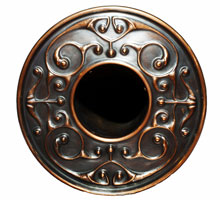 Conference and concert Conference and concertViterbo, November 11th – 14th, 2015, Aula Magna del complesso storico di S. Maria in Gradi, Università degli Studi della Tuscia Brass instruments play an important part in EMAP, partly because so many have survived and partly because they played such an important role in both the ritual and artistic life of the past. The 2015 EMAP Conference in Viterbo will gather together all these instruments to celebrate their past, bringing with them researchers, makers and players to join together in the task of reawakening the spirits of the ancient world.  Seminar and Workshop Seminar and Workshop
Instrumentos musicales de barro: Arqueología, Etnografía y Experimentación
(Clay Musical instruments: Archaeology, Etnography and Experimentation)
Spain (Bailén), 8-11th September 2015
The University of Valladolid and the European Music Archaeology Project are organizing
in Bailén (Jaén) a Seminar and Workshop in collaboration with the Municipality of Bailén,
a village well known for its ancient pottery traditions. The seminar will be dedicated to the
study of the production process of clay musical instruments both from the perspective of
archaeology and ethnography, bringing together researchers and traditional craftsmen.
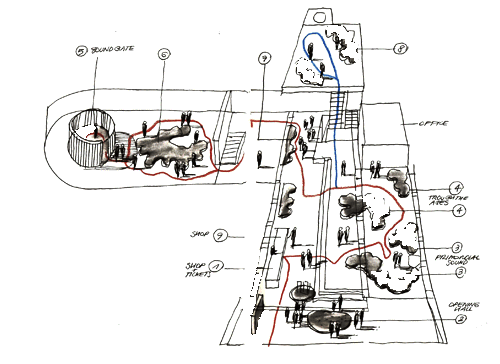
ARCHÆOMUSICA
Exploring the Sounds and Music of Ancient Europe
The exhibition will tour Europe between June 2016 and December 2017 (for the venues, click here). Drawing upon innovative approaches to exhibition making, an experience of the dimensions of sound and space of past cultures will be made possible using visual and multimedia approaches. Visitors will discover an unheard world of sound in ancient Europe, in which the unifying elements of music without boundaries are a constant theme.
The exhibition reflects the diverse nature of music-archaeological research, from discovery to instrument making and experimental playing, and from experimental playing to sound design and soundscape research. Wherever it travels, it will be accompanied by a programme of satellite events, with artists selected from a large pool of professional musicians, performers, lecturers and instrument makers (for the events, click here).
High-quality replicas of ancient sound artefacts and depictions will be provided both for visual display and hands-on exploration. In support, interactive multimedia materials will accompany the physical artefacts. The multimedia materials will be designed according to the most up-to-date international exhibition standards, linking visual and performing arts and scientific research in an innovative way.
|
MUSIKALISCHES OEUVRE IX (ZU LEBZEITEN PUBL. KL. WERKE)
Notturno (Guarda che bianca luna)
Occupation:
Soprano, tenor and bass obbligato flute and piano
Text:
Jacopo Vittorelli
Emergence, Autograph and expenditures:
dated: February 26, 1839. Autograph: Milan, Museo teatrale alla Scala - Score: Milan: Canti [1839] # 392..
Genesis, text and commentary
Musicological essays & Publications
Duration:
Approximately 4 minutes
discography:
The discographic information will be published here as soon as possible.
Back to the main body of work? (Click here)
Back to the main foundation? (Click here)
MUSICAL OEUVRE IV
(With additional OPERN. BALLET MUSIC)
Nabucodonosor (Nabucco)
Occupation:
Soprano, tenor and bass obbligato flute and piano
Text:
Jacopo Vittorelli
Emergence, Autograph and expenditures:
dated: February 26, 1839. Autograph: Milan, Museo teatrale alla Scala - Score: Milan: Canti [1839] # 392..
Genesis, text and commentary
Musicological essays & Publications
Duration:
Approximately 4 minutes
discography:
The discographic information will be published here as soon as possible.
Back to the main body of work? (Click here)
Back to the main foundation? (Click here)
MUSICAL OEUVRE IV
(With additional OPERN. BALLET MUSIC)
Nabucodonosor (Nabucco)

| Sei romanze II (1845) |
1. Il tramonto (Amo l’ora del giorno che muore) 2. La zingara (Chi padre mi fosse, qual patria mi sia) 3. Ad una stella (Bell’astro della terra) 4. Lo spazzacamino (Son d’aspetto brutto e nero) 5. Il mistero (Se tranquillo a te daccanto) 6. Brindisi(Mescetemi il vino!)
|
 |
Besetzung:
Sopran/Tenor und Klavier.
Texte:
1., 3. und 6. Andrea Maffei; 2. und 4. Manfredo Maggioni; 5. Felice Romani
Entstehung, Autograph und Ausgaben:
vor 1845. Autograph: Mailand, Verlags-Archiv Ricordi – Ausgaben: Mailand: Lucca [1845], Nr. 5640–5645;Composizioni da camera per canto e pianoforte, Mailand: Ricordi 1935, Nr. 123381.
Aufführungsdauer:
Ca. 18 Minuten.
Diskographie:
Die diskographische Information wird so bald wie möglich hier veröffentlicht.Six Romance II (1845)
1. The sunset (I love the man of the day he dies) 2. The gypsy (Chi father was to me, which is home to me) 3. For a star (Bell'astro earth) 4. The Chimney Sweep (Son waiting ugly and black) 5. the mystery (If you quiet daccanto) 6. Brindisi (Pour me some wine!)
Besetzung:
Sopran / Tenor und Klavier.
texte:
1., 3. und 6. Andrea Maffei; 2. und 4. Manfredo Maggioni; 5. Felice Romani
Entstehung, Autograph und Ausgaben:
vor 1845. Autograph: Mailand, Verlags-Archiv Memories - Ausgaben: Mailand: Lucca [1845], no. 5640-5645; Chamber compositions for voice and piano, Mailand: Remember 1935, Nr. 123381.
Entstehungsgeschichte, Text und Kommentar
Musikwissenschaftliche Aufsätzen & Publikationen
Aufführungsdauer:
Ca. 18 Minuten.
Diskographie:
Die diskographische so bald wie möglich Information wird hier veröffentlicht.
|
About Moulin Rouge
“With the old kindness, the old distinguished grace,
She lies, her lovely piteous head amid dull red hair
Propped upon pillows, rouge on the pallor of her face.
She would not have us sad because she is lying there,
And when she meets our gaze her eyes are laughter-lit,
Her speech a wicked tale that we may vie with her....”
—William Butler Yeats (1865–1939)
“Right now I think censorship is necessary; the things they’re doing and saying in films right now just shouldn’t be allowed. There’s no dignity anymore and I think that’s very important.”
—Mae West (1892–1980)
She lies, her lovely piteous head amid dull red hair
Propped upon pillows, rouge on the pallor of her face.
She would not have us sad because she is lying there,
And when she meets our gaze her eyes are laughter-lit,
Her speech a wicked tale that we may vie with her....”
—William Butler Yeats (1865–1939)
“Right now I think censorship is necessary; the things they’re doing and saying in films right now just shouldn’t be allowed. There’s no dignity anymore and I think that’s very important.”
—Mae West (1892–1980)
Famous quotes containing the words film and/or music:
“All the old supports going, gone, this man reaches out a hand to steady himself on a ledge of rough brick that is warm in the sun: his hand feeds him messages of solidity, but his mind messages of destruction, for this breathing substance, made of earth, will be a dance of atoms, he knows it, his intelligence tells him so: there will soon be war, he is in the middle of war, where he stands will be a waste, mounds of rubble, and this solid earthy substance will be a film of dust on ruins.”
—Doris Lessing (b. 1919)
—Doris Lessing (b. 1919)
“In benevolent natures the impulse to pity is so sudden, that like instruments of music which obey the touch ... you would think the will was scarce concerned, and that the mind was altogether passive in the sympathy which her own goodness has excited. The truth is,—the soul is [so] ... wholly engrossed by the object of pity, that she does not ... take leisure to examine the principles upon which she acts.”
—Laurence Sterne (1713–1768)
—Laurence Sterne (1713–1768)
Tuesday, April 5, 2016
The Story Behind Kimono
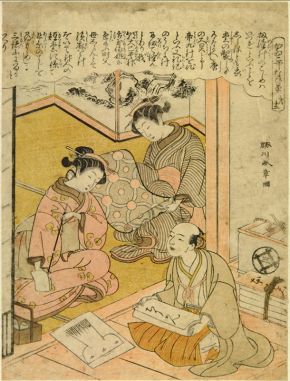 Woodblock print, 'The Cultivation of Silkworms', Katsukawa Shunsho (1726-1792), Japan, 1767-1768. Museum no. E.1360-1922, © Victoria and Albert Museum, London
Woodblock print, 'The Cultivation of Silkworms', Katsukawa Shunsho (1726-1792), Japan, 1767-1768. Museum no. E.1360-1922, © Victoria and Albert Museum, London
Kimono are made from single bolts of cloth, about 36cm wide and 11 metres long, which are cut into seven straight pieces. Two panels - each extending up the front, over the shoulder and down the back - create the body, two the sleeves, two more the overlaps, and a narrower panel the neckband.
This simplicity of construction meant that kimono could be sewn in the home. In the Edo period many households, particularly in rural areas, also had their own loom, and a woman's sewing and weaving abilities were considered very important. The creation of sumptuous silk kimono, however, required the skills of specialist artisans, the majority of whom were men. Fashion was big business and supported an extensive network that included spinners, weavers, dyers, embroiderers, specialist thread suppliers, stencil makers and designers. At the heart of the industry were the drapery stores, the most famous of which was the Echigo-ya in Edo founded in 1673 by Mitsui Takatoshi. Merchants such as Mitsui not only sold kimono fabric, but orchestrated the activities of the various specialist workshops involved in the creation of individually commissioned garments.
When choosing a kimono design, customers, and also the makers and sellers of kimono, could turn to pattern books (hinagata-bon) for assistance. These contained illustrations of the back of kimono with accompanying notes on colour and decoration. Books showing kimono being worn were also published, not so much to provide practical help but for the pleasure of thumbing through them, rather like today's fashion magazines.
The western textile technology introduced to Japan in the Meiji period speeded up production and lowered costs. At the turn of the 20th century many drapery stores transformed themselves into modern departments stores. Echigo-ya, for example, became Mitsukoshi, which remains one of Japan's leading retailers. Since the Second World War the wearing of traditional garments has dramatically declined, but today such stores still have kimono departments. Nowadays most production is automated, but some makers continue to utilise traditional skills in the creation of contemporary kimono.
Dyeing techniques

Kimono, Japan, 1800-1850, silk crepe (chirimen) with tie-dyeing (shibori), paste-resist dyeing (yuzen) and embroidery. Museum no. T.109-1954, © Victoria and Albert Museum, London
Most of the dyes used to colour Japanese textiles, and many of the techniques used to apply them, have a history that dates back to the 8th century. However, it was not until the Edo period that the sophisticated dyed designs for which Japan is famous fully developed. Dyeing is a very specialised skill and the top dye houses carefully guarded their secrets. Kyoto was the dye centre of Japan, but no village was without its own dye house.
In Japan a variety of resist-dyeing methods are used. Shibori, or tie-dyeing, involves the binding, stitching, folding or clamping of the cloth prior to immersion in the dye, the colour thus not penetrating the protected areas. In one of the most distinctive Japanese techniques, kanoko shibori, closely placed small circles in diagonal rows are bound tightly with thread before dyeing. In stencil dyeing, or katazome, rice paste is applied through a stencil onto the cloth. The stencil is then removed and placed on the next section of fabric and the process repeated. When the cloth is dyed the colour does not penetrate the areas covered with the paste, which is then washed away once the dye is dry.
Rice paste is also utilised in yūzen, in which a cloth tube fitted with a metal tip is used to apply a thin ribbon of paste to the outline of a drawing on the fabric. Dyes are then brushed within the paste boundaries. This technique, named after Miyazaki Yūzen, the artist monk credited with inventing it, developed in the 18th century. It allowed for extremely detailed patterning and gave kimono designers almost unlimited freedom of expression.
In the second half of the 19th century the dyer's palette was expanded by the introduction of chemical dyes and in the late 1870s a method was devised of directly applying pre-coloured paste through stencils. In the 20th century traditional methods of dyeing survived alongside increasingly automated methods and today are preserved by a number of leading kimono makers who use them to create highly contemporary designs.
Embroidery

Kimono, Japan, 1820-60, satin silk known as shu, embroidered in silk & metallic thread with decoration of ducks on rippling water amongst irises and pinks. Museum no. T.79-1927, © Victoria and Albert Museum, London
Like other patterning methods, Japanese embroidery has a long history and reached its peak of technical sophistication in the Edo period. Exploiting the freedom the technique allows, and utilising a myriad of colours and an extensive range of stitches, embroiderers have produced some of the most striking of all Japanese textiles. Embroidery was often used in conjunction with dyeing, the combination of techniques giving designs a variety of texture and visual depth. When embroidery was the sole decorative method, a satin fabric was commonly used, giving an extremely lustrous effect.
Japanese embroiderers employ a number of different stitches. A flat stitch (hira-nui), equivalent to satin stitch in the West, is used to create pattern elements such as flowers and leaves. These stitches use floss (untwisted) silk, which gives the embroidery a very rich sheen. A tiny gap, equivalent to the point of the needle, is used to delineate elements such as the separate petals of flowers or the central veins of leaves. Larger areas are defined with long and short stitches (sashi-nui), also in floss silk. Twisted threads, generally in pairs, are also used. In katayori, one thread is highly twisted and then twisted, more lightly and in the opposite direction, with another thread, giving a nubbled appearance. Another type of texture is created with a knot stitch (sagura-nui). Metallic thread is also used to dazzling effect in Japanese embroidery. This is made from a silk core wrapped in paper and then with gold or silver leaf. The resulting thread is too thick to pass through fine silk without damaging it, so is couched (attached with small stitches) on to the fabric.
In Japan a number of other decorative techniques involve the use of a needle and thread. In Tsugaru, the northernmost part of Japan's main island Honshū, kimono are embellished using a method called kogin, in which white stitches are embroidered over and under an odd number of warps on the woven ground fabric to create a diamond pattern.
Weaving techniques

Kimono, 'Blue Mountains and Green Rivers', Tsuchiya Yoshinori, Japan, 2004. Museum no. FE.144-2006, © Victoria and Albert Museum, London
The simplest way of weaving fabric is to pass the weft (horizontal) thread over and under each successive warp (vertical) thread. This is known as plain weave (hira-ori) and in Japan is the principal method used in the creation of cotton, hemp, ramie and certain kinds of silk fabrics.
Stripes and checks are produced by using different coloured threads, while more elaborate patterns can be created by weaving with selectively pre-dyed threads, as in the technique known as kasuri. Silk crepe (chirimen) is also a plain weave, but has a crimped appearnance that is produced by over-twisting the weft threads.
Passing the weft over or under two or more warps creates what is known as a float. In satin (shu) long floats are created by passing the weft over or under four or more warps which gives the fabric a lustrous appearance.
In float weaves the surface of the fabric can show either predominantly warps or predominantly wefts depending on the weaving sequence. By using different combinations of floats, patterns can be created in the cloth as in rinzu, a monochrome figured satin similar to damask. Like chirimen, rinzu was introduced to Japan from China in the 16th century.The patterns that adorn kimono are very significant, for it is through choice of colour and, most importantly, decorative motifs that the wearer's gender, age, status, wealth, and taste are articulated.
At the beginning of the Edo period there were no substantial differences between the kimono worn by men and women, but distinctions became more pronounced in the course of the 17th century. The patterns on women's kimono became larger and bolder. Younger women's kimono were particularly lavishly decorated and brightly coloured, while more subtle patterning and subdued colours were considered appropriate for an older woman. The length of the sleeve also varied. Young women wore their sleeves long, a fashion that became particularly pronounced from the mid-Edo period onwards, but shortened them once they married. Men wore even shorter sleeves, while the patterns and colouring on their garments was generally quite restrained.
At the beginning of the 17th century the surface of the kimono was divided into irregular pattern areas. Over time such compartmentalisation gave way to an approach which considered the garment as a whole, and in which technique and motif, pattern and ground were fully integrated. The disposition of the pattern on the surface of the garment also changed over time. Nature, particularly seasonal references, provided a major source of designs, together with allusions to classical literature. The increased market for luxury kimono led to a broadening of the visual repertoire to include aspects of popular culture and visual puns. The range of patterns widened yet further during the late 19th century when western motifs were introduced.
With the taste for dynamic, unified motifs, the clean, straight lines of the T-shaped garment served as a blank canvas, or scroll, for the kimono designer. It is important to remember, however, that kimono are 3-dimensional objects that move with the wearer. The simplicity of structure also belies the fact that donning a kimono, often in a number of layers, with an obi and other accessories, creates a rich and often visually complex effect.
Symbolism

Kimono, Japan, early 19th - mid 20th century. Museum no. T.18-1963, © Victoria and Albert Museum, London
The images used on kimono often have complex levels of meaning, and many have specific auspicious significance which derives from religious or popular beliefs. The crane for example, is one of the most popular birds depicted on kimono. Believed to live for a thousand years and to inhabit the land of the immortals it is a symbol of longevity and good fortune.
The use of specific motifs can allude to the virtues or attributes of the wearer (or those they might aspire to), reflect particular emotions, or relate to the season or occasion. Such symbolism was used especially on kimono worn for celebratory events such as weddings and festivals, when it served to bestow good fortune on the wearer, wrapping them in divine benevolence and protection. This use of auspicious motifs in dress reveals the Japanese belief in the literal, as well as the figurative, power of images.
Colours too have strong metaphorical and cultural connotations. Dyes are seen to embody the spirit of the plants from which they are extracted. Any medicinal property is also believed to be transferred to the coloured cloth. Blue, for example, derives from indigo (ai), which is used to treat bites and stings, so wearing blue fabric serves as a repellent to snakes and insects. Colours were given a cosmological dimension with the introduction to Japan in the 6th century of the Chinese concept of the five elements. Fire, water, earth, wood and metal are associated with particular directions, seasons, virtues and colours. Thus black corresponds to water, north, winter and wisdom. Colours also have strong poetic significance. Purple, for example, is a metaphor for undying love, the imagery deriving from the fact that gromwell (murasaki), the plant used to create the dye, has very long roots. Perhaps the most popular colour for kimono is red, derived from safflower (benibana). Red connotes youthful glamour and allure, and is thus suitable for the garments of young women. It is also a symbol of passionate but, as beni-red easily fades, transient love.
Natural motifs
The natural world provides the richest source for kimono motifs. Numerous flowers such as peonies, wisteria, bush clover and hollyhocks appear on garments. Many of them, for example cherry blossom, chrysanthemums and maple leaves, have a seasonal significance.
Pine, bamboo and plum are known collectively as the Three Friends of Winter (shōchikubai), and are symbols of longevity, perseverance and renewal. The pine tree is an evergreen and lives for many years, bamboo bends in the wind but never breaks, and the plum is the first tree to blossom each year. The plum is particularly favoured for winter kimono, for its use suggests that spring cannot be far away.
Birds, animals, butterflies and dragonflies also appear on kimono, along with other motifs drawn from the natural world such as water, snow and clouds. On some kimono whole landscapes of mountains and streams are depicted. The numerous different ways in which such popular natural motifs are used on garments is testament to the skill of kimono designers, and of dyers and embroiderers.
Poems & stories
Elements of the natural world that appear on kimono usually have strong poetic associations, while more complex landscape scenes often refer to particular stories drawn either from classical literature or popular myths.While carrying an auspicious meaning, they also serve to demonstrate the literary discernment and cultural sensitivities of the wearer.Although such stories invariably involved people, it is relatively unusual to find human figures depicted on kimono. Instead there are objects which suggest their presence or recent departure, a pair of dropped fans, for example, alluding to lovers disturbed.
From the early 20th century increasingly graphic imagery was used on kimono. On garments for young boys in particular, symbols of Japan's modern and progressive present - cars, trains, aeroplanes and skyscrapers - became as popular as stories of the past. In the 1930s such motifs became increasingly nationalistic and militaristic.
Edo period (1615-1868)

Kimono, Japan, 1780-1830, crepe silk with paste-resist decoration (chaya-zome), stencilled imitation tie-dye (kata kanoko) and embroidery in silk and metallic thread. Museum no. FE.12-1983, © Victoria and Albert Museum, London
The Edo period was one of unprecedented political stability, economic growth, and urban expansion. Kyoto, the old capital, remained the centre of aristocratic culture and luxury production while Edo, the new headquarters chosen by the Tokugawa shōgun (military ruler), developed from a small fishing port into one of the largest cities in the world. In Edo and elsewhere, a dynamic urban culture developed in which fashionable dress played a central role.
The primary consumers of sumptuous kimono were the samurai, the ruling military class.Yet it was the merchant and artisan classes, or chōnin, who benefited most from the peace and prosperity of the period. However, the rigid hierarchy of Tokugawa Japan meant that they could not use their wealth to improve their social status. Instead they had to find different outlets for their money, such as buying beautiful clothes. It was this new market that stimulated the great flowering of the textile arts in the Edo period. The kimono developed into a highly expressive means of personal display, an important indicator of the rising affluence and aesthetic sensibility of the chōnin.There were even fashion contests between the wives of the wealthiest merchants, who tried to outdo one another with ever more dazzling displays of splendid costume.Such excesses troubled the shogunate as they threatened to upset the strict social order and sumptuary laws that restricted the kind of fabrics, techniques and colours used by the chōnin were periodically issued.
Although the laws were not consistently enforced, leading to regular shifts between opulence and restraint, they did usher in certain changes. New techniques were developed and the use of subdued colours and fabrics became increasingly common. This was part of a new aesthetic known as iki, or elegant chic, in which anyone with real taste focussed on subtle details.Those with style and money also found other ways to circumvent the rules. It became very fashionable, for example, to use the highly coveted, but forbidden, colour red on undergarments and linings, for these were not covered by the restrictions.
Meiji period (1868-1912)

Kimono, Japan, 1870-1880, crepe silk (chirimen), paste-resist decoration (yuzen) and embroidery. Museum no. FE.29-1987, © Victoria and Albert Museum, London
In 1853 an American naval squadron arrived off the coast of Japan demanding that the country open its ports to western powers. This external pressure combined with internal unrest and led to revolution, the overthrow of the shōgun and the restoration of the Meiji Emperor in 1868. The imperial court moved to Edo, which was renamed Tokyo.
The new government realized that the only way Japan would be able to compete with the military and industrial might of the West was to transform itself along western lines. An unprecedented period of transformation was launched that was to affect all areas of life, including clothing. It was at this point that the word 'kimono', the thing worn, was coined to define T-shaped garments as opposed to western-style ones.
Some members of the elite adopted western dress because of its association with the concepts of civilisation, modernisation and progress that the Meiji government sought to promote. Dress also began to diverge along lines of place and gender as men started to wear business suits for work. While men usually changed into kimono when at home in the private sphere, women, who tended to inhabit only the domestic space, continued to wear kimono most of the time. Interestingly, Japan's textile industry was one of the first to adopt western science and technology. Using new techniques silk fabric was produced in greater qualities and at reasonable prices. Many women could afford to buy silk kimono for the first time and, with the end of the Tokugawa shogunate and the sumptuary laws, were not forbidden from wearing them.
The 'opening' of Japan aroused enormous interest in the West and the flood of information and goods that subsequently reached Europe and America led to a craze for all things Japanese. Kimono were exported to the West, and by the 1870s were available to buy in shops such as Liberty's in London.
The interwar years

Kimono, Japan, 1934, silk crepe with resist-dyeing and embroidery. Museum no. FE.138-2002, © Victoria and Albert Museum, London
The Taishō period (1912-1926) was one of confidence and optimism in Japan. Industrial development was stimulated by the First World War, economic prosperity being matched by political democratisation. It was a period of great urban growth, particularly in the capital, Tokyo. People moved to the suburbs, commuting on expanding railway networks to new types of office and factory jobs. Women entered the work force in large numbers, employed as typists, bank clerks, bus conductors and shop assistants. These workers were the consumers of a new mass urban culture that centred on the café, the cinema and the department store.
Although western-style clothes gained popularity among women, the kimono continued to be worn. The traditional cut of the garment remained the same, but the motifs were dramatically enlarged and new designs appeared, inspired by western styles such as Art Nouveau and Art Deco. Their striking patterns reflected the confident spirit of the age and provided an exuberant visual statement for the modern, independent, urban woman of the Taishō and early Shōwa periods (1926-1989).
In creating these boldly patterned and brilliantly coloured kimono, textile designers benefited from technological advances made during the late 19th century. Power-operated spinning machines and jacquard looms introduced from Europe had speeded up production and lowered costs, while chemical dyes allowed for the creation of dazzling colours. In the early 20th century new types of silk and innovative patterning techniques were also developed, making relatively inexpensive, highly fashionable garments available to more people than ever before. These vibrant kimono styles remained popular until the 1950s.
Kimono today

Kimono, 'Spring', Matsuda Eriko, Japan, 2005-2006. Museum no. FE.145-2006, © Victoria and Albert Museum, London
Since the end of the Second World War western-style clothing has been the everyday wear of most Japanese. The older generation often continue to wear kimono, as do geisha, actors, and those serving in traditional restaurants or engaged in activities such the tea ceremony. Generally however, kimono are only worn at a limited number of formal occasions and there are fairly rigid guidelines about what type of garment is appropriate for what event.
Kimono are also very expensive. If this limits the wearing of them, it also proclaims their high cultural value. Indeed, the garment may be worn much less, but its symbolic importance has grown. As Japan has come to define itself within the western world since the late 19th century, the kimono has come to mark a boundary with the foreign, to stand for the essence that is Japanese. This is reflected in the fact that most contemporary textile designers working with traditional techniques still use the kimono as the primary format for their artistic expression.
The 21st century, however, has witnessed something of a kimono renaissance. Elegant kimono in beautiful modern fabrics can be seen increasingly on the streets of Japan, while second-hand kimono are becoming popular with the young, who often re-style them or combine them with other items of dress. The resurgence of interest in kimono is particularly apparent in the summer, when department stores are full of yukata (summer kimono), which are much simpler to wear than formal garments. After the Second World War kimono were often viewed as a product of Japan's feudal past or a symbol of woman's oppression, but today they are just another choice in a woman's - and even occasionally a man's - wardrobe. They are an item of fashion, just as they were in their Edo heyday.
Subscribe to:
Comments (Atom)
